Workplace Law Assignment: Case Studies and Legal Principles
VerifiedAdded on 2022/12/14
|19
|4439
|74
Homework Assignment
AI Summary
This assignment delves into various aspects of workplace law, encompassing case scenarios and legal principles. It begins with an introduction to workplace laws and regulations, followed by an analysis of five distinct case scenarios. The first part of the assignment addresses fundamental concepts such as the Better Off Overall Test, employee confidentiality, the role of the Federal Circuit Court in employment termination, legislative minimum notice protections, and the relevance of modern awards. The second part applies these concepts to specific scenarios, exploring issues like workplace injuries, unfair dismissal, union complaints to the Fair Work Commission, industrial action, and variations in employment duties. Each case study utilizes the IRAC method, identifying legal issues, outlining relevant rules, applying the rules to the facts, and concluding with a reasoned outcome. The assignment provides a comprehensive overview of key workplace law principles and their practical application.
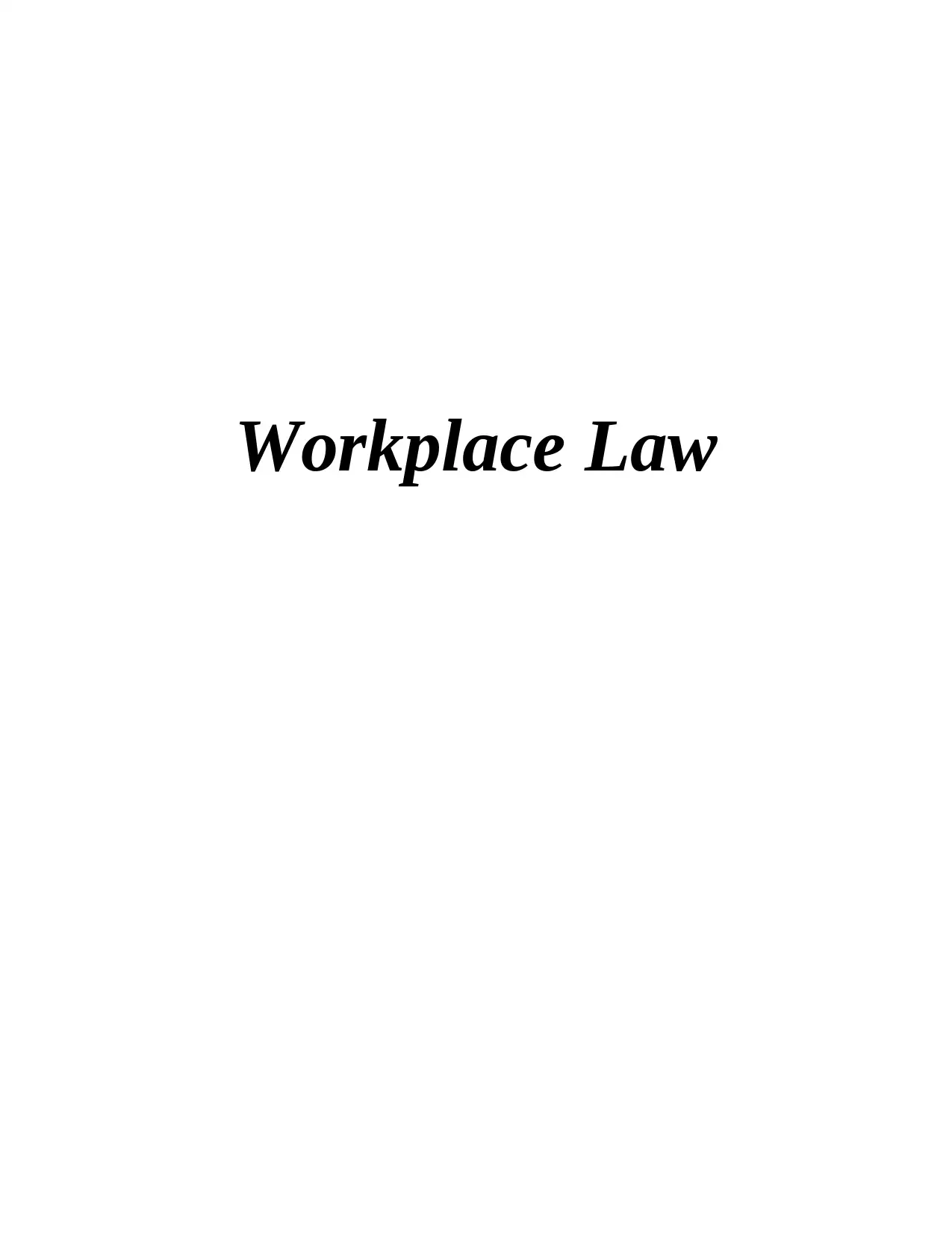
Workplace Law
Paraphrase This Document
Need a fresh take? Get an instant paraphrase of this document with our AI Paraphraser
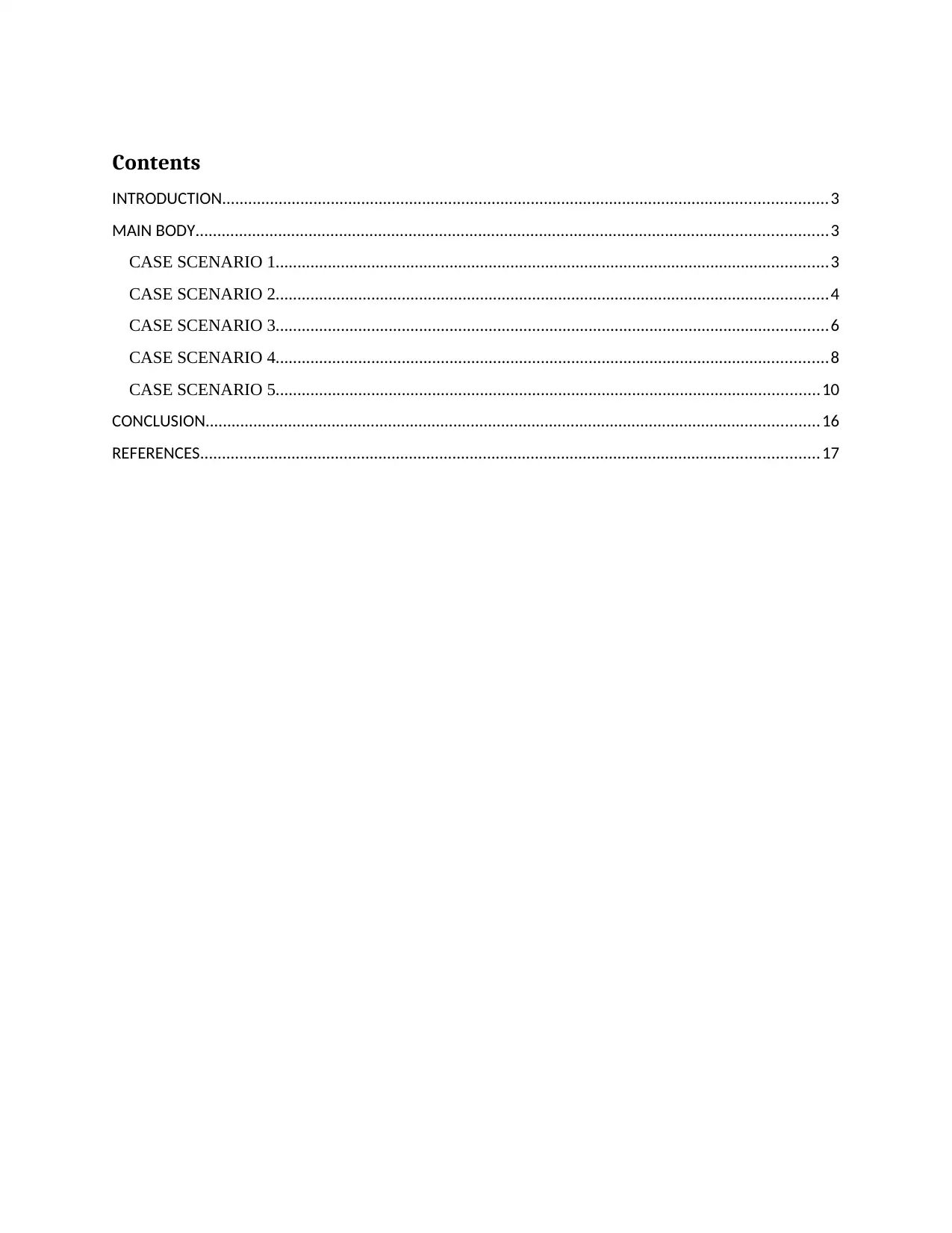
Contents
INTRODUCTION...........................................................................................................................................3
MAIN BODY.................................................................................................................................................3
CASE SCENARIO 1...............................................................................................................................3
CASE SCENARIO 2...............................................................................................................................4
CASE SCENARIO 3...............................................................................................................................6
CASE SCENARIO 4...............................................................................................................................8
CASE SCENARIO 5.............................................................................................................................10
CONCLUSION.............................................................................................................................................16
REFERENCES..............................................................................................................................................17
INTRODUCTION...........................................................................................................................................3
MAIN BODY.................................................................................................................................................3
CASE SCENARIO 1...............................................................................................................................3
CASE SCENARIO 2...............................................................................................................................4
CASE SCENARIO 3...............................................................................................................................6
CASE SCENARIO 4...............................................................................................................................8
CASE SCENARIO 5.............................................................................................................................10
CONCLUSION.............................................................................................................................................16
REFERENCES..............................................................................................................................................17

INTRODUCTION
The laws are the rules and regulations which governs the working of businesses and
people. There are many laws which come under the facet of workplace which includes fair work
Act, trademark Act, contract law and many others which regulates the working of businesses
(Forsyth, 2107). This report shall deal with five case scenarios which are relating to workplace
and employment.
PART 1
What is the Better Off Overall Test about? When is it relevant and who applies it?
It comprises of the terms which are less and more beneficial to the employees as
compared to the terms enumerated in the modern award. It requires identification of the
agreement terms that are less and more beneficial to employees and then the overall assessment
is made to see whether the employees would be better under the agreement than the relevant
award. The Fair Work Commission applies it to assess the conditions of workers in new
agreement.
Explain what the employee’s duty of confidentiality is. Does it have anything to do with restraint
of trade clauses?
The clause of confidentiality mainly defines the information which is considered by the
employee to be confidential and also prohibits an employee from making any disclosure during
the employment and after the termination indefinitely. In the case of Sportsbet Pty Ltd v.
Carpanini and another, the court held that the enforceability of the clause of restraint of trade
falls for the consideration which gives regard to confidential information and the duties
performed by employee.
The laws are the rules and regulations which governs the working of businesses and
people. There are many laws which come under the facet of workplace which includes fair work
Act, trademark Act, contract law and many others which regulates the working of businesses
(Forsyth, 2107). This report shall deal with five case scenarios which are relating to workplace
and employment.
PART 1
What is the Better Off Overall Test about? When is it relevant and who applies it?
It comprises of the terms which are less and more beneficial to the employees as
compared to the terms enumerated in the modern award. It requires identification of the
agreement terms that are less and more beneficial to employees and then the overall assessment
is made to see whether the employees would be better under the agreement than the relevant
award. The Fair Work Commission applies it to assess the conditions of workers in new
agreement.
Explain what the employee’s duty of confidentiality is. Does it have anything to do with restraint
of trade clauses?
The clause of confidentiality mainly defines the information which is considered by the
employee to be confidential and also prohibits an employee from making any disclosure during
the employment and after the termination indefinitely. In the case of Sportsbet Pty Ltd v.
Carpanini and another, the court held that the enforceability of the clause of restraint of trade
falls for the consideration which gives regard to confidential information and the duties
performed by employee.
⊘ This is a preview!⊘
Do you want full access?
Subscribe today to unlock all pages.

Trusted by 1+ million students worldwide
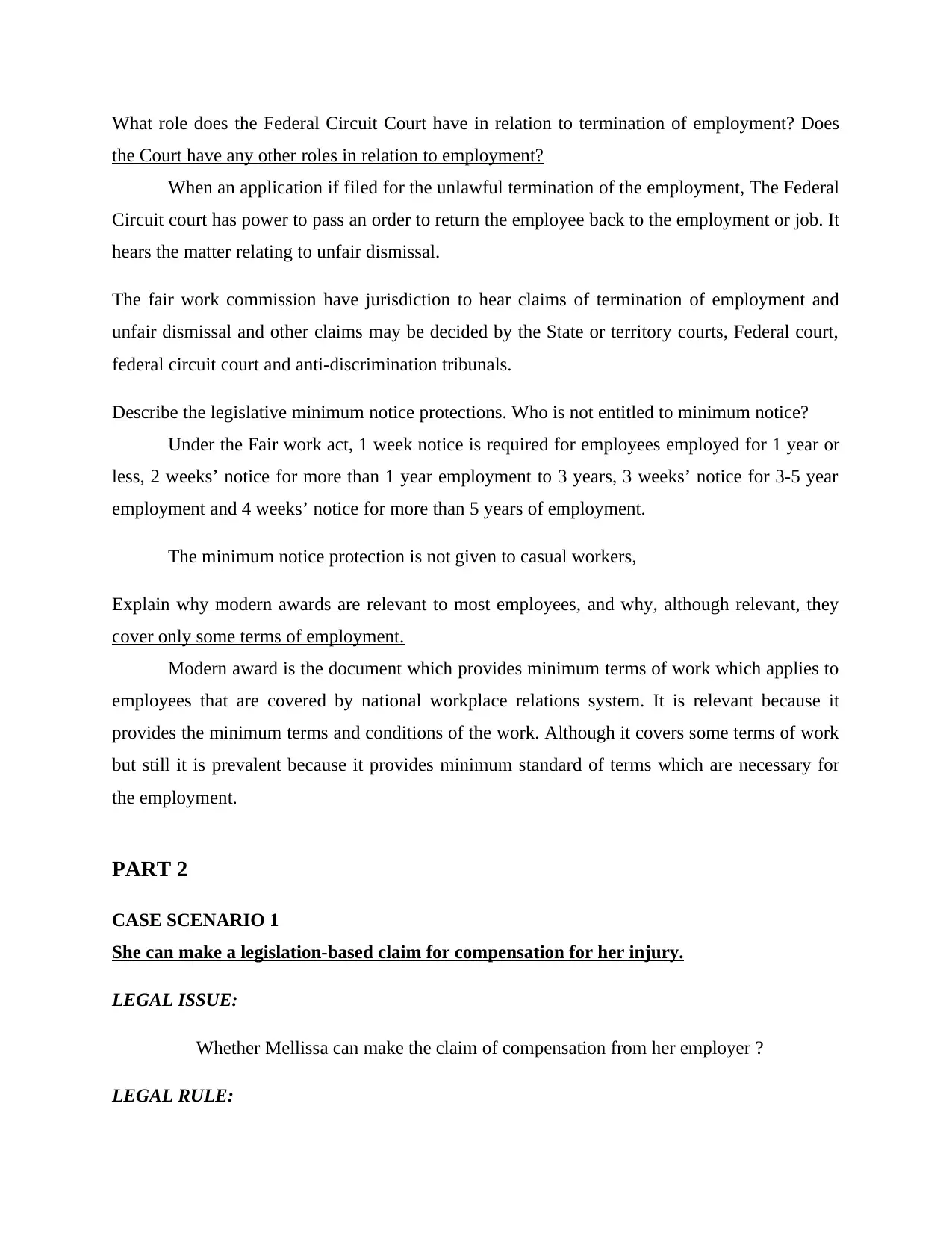
What role does the Federal Circuit Court have in relation to termination of employment? Does
the Court have any other roles in relation to employment?
When an application if filed for the unlawful termination of the employment, The Federal
Circuit court has power to pass an order to return the employee back to the employment or job. It
hears the matter relating to unfair dismissal.
The fair work commission have jurisdiction to hear claims of termination of employment and
unfair dismissal and other claims may be decided by the State or territory courts, Federal court,
federal circuit court and anti-discrimination tribunals.
Describe the legislative minimum notice protections. Who is not entitled to minimum notice?
Under the Fair work act, 1 week notice is required for employees employed for 1 year or
less, 2 weeks’ notice for more than 1 year employment to 3 years, 3 weeks’ notice for 3-5 year
employment and 4 weeks’ notice for more than 5 years of employment.
The minimum notice protection is not given to casual workers,
Explain why modern awards are relevant to most employees, and why, although relevant, they
cover only some terms of employment.
Modern award is the document which provides minimum terms of work which applies to
employees that are covered by national workplace relations system. It is relevant because it
provides the minimum terms and conditions of the work. Although it covers some terms of work
but still it is prevalent because it provides minimum standard of terms which are necessary for
the employment.
PART 2
CASE SCENARIO 1
She can make a legislation-based claim for compensation for her injury.
LEGAL ISSUE:
Whether Mellissa can make the claim of compensation from her employer ?
LEGAL RULE:
the Court have any other roles in relation to employment?
When an application if filed for the unlawful termination of the employment, The Federal
Circuit court has power to pass an order to return the employee back to the employment or job. It
hears the matter relating to unfair dismissal.
The fair work commission have jurisdiction to hear claims of termination of employment and
unfair dismissal and other claims may be decided by the State or territory courts, Federal court,
federal circuit court and anti-discrimination tribunals.
Describe the legislative minimum notice protections. Who is not entitled to minimum notice?
Under the Fair work act, 1 week notice is required for employees employed for 1 year or
less, 2 weeks’ notice for more than 1 year employment to 3 years, 3 weeks’ notice for 3-5 year
employment and 4 weeks’ notice for more than 5 years of employment.
The minimum notice protection is not given to casual workers,
Explain why modern awards are relevant to most employees, and why, although relevant, they
cover only some terms of employment.
Modern award is the document which provides minimum terms of work which applies to
employees that are covered by national workplace relations system. It is relevant because it
provides the minimum terms and conditions of the work. Although it covers some terms of work
but still it is prevalent because it provides minimum standard of terms which are necessary for
the employment.
PART 2
CASE SCENARIO 1
She can make a legislation-based claim for compensation for her injury.
LEGAL ISSUE:
Whether Mellissa can make the claim of compensation from her employer ?
LEGAL RULE:
Paraphrase This Document
Need a fresh take? Get an instant paraphrase of this document with our AI Paraphraser
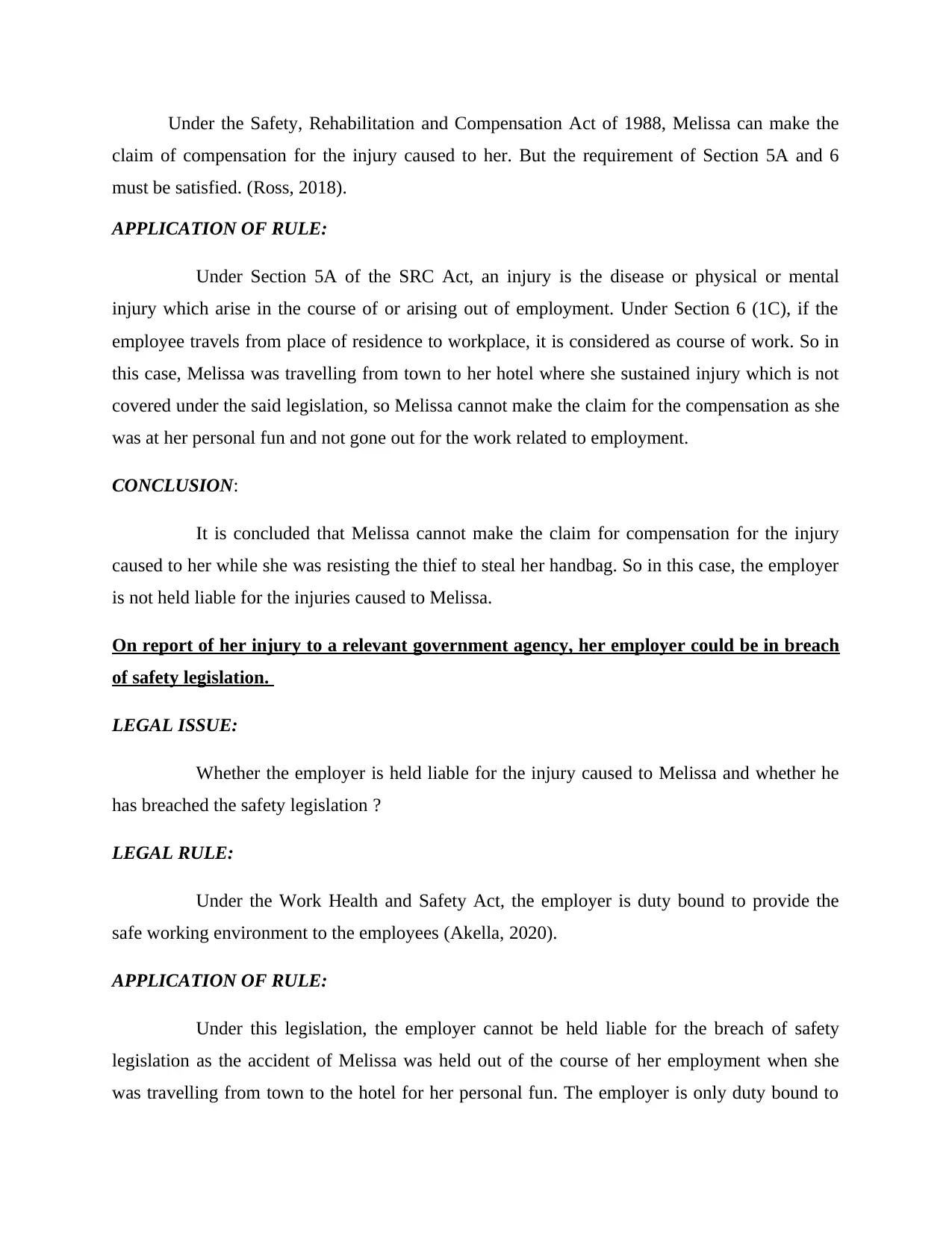
Under the Safety, Rehabilitation and Compensation Act of 1988, Melissa can make the
claim of compensation for the injury caused to her. But the requirement of Section 5A and 6
must be satisfied. (Ross, 2018).
APPLICATION OF RULE:
Under Section 5A of the SRC Act, an injury is the disease or physical or mental
injury which arise in the course of or arising out of employment. Under Section 6 (1C), if the
employee travels from place of residence to workplace, it is considered as course of work. So in
this case, Melissa was travelling from town to her hotel where she sustained injury which is not
covered under the said legislation, so Melissa cannot make the claim for the compensation as she
was at her personal fun and not gone out for the work related to employment.
CONCLUSION:
It is concluded that Melissa cannot make the claim for compensation for the injury
caused to her while she was resisting the thief to steal her handbag. So in this case, the employer
is not held liable for the injuries caused to Melissa.
On report of her injury to a relevant government agency, her employer could be in breach
of safety legislation.
LEGAL ISSUE:
Whether the employer is held liable for the injury caused to Melissa and whether he
has breached the safety legislation ?
LEGAL RULE:
Under the Work Health and Safety Act, the employer is duty bound to provide the
safe working environment to the employees (Akella, 2020).
APPLICATION OF RULE:
Under this legislation, the employer cannot be held liable for the breach of safety
legislation as the accident of Melissa was held out of the course of her employment when she
was travelling from town to the hotel for her personal fun. The employer is only duty bound to
claim of compensation for the injury caused to her. But the requirement of Section 5A and 6
must be satisfied. (Ross, 2018).
APPLICATION OF RULE:
Under Section 5A of the SRC Act, an injury is the disease or physical or mental
injury which arise in the course of or arising out of employment. Under Section 6 (1C), if the
employee travels from place of residence to workplace, it is considered as course of work. So in
this case, Melissa was travelling from town to her hotel where she sustained injury which is not
covered under the said legislation, so Melissa cannot make the claim for the compensation as she
was at her personal fun and not gone out for the work related to employment.
CONCLUSION:
It is concluded that Melissa cannot make the claim for compensation for the injury
caused to her while she was resisting the thief to steal her handbag. So in this case, the employer
is not held liable for the injuries caused to Melissa.
On report of her injury to a relevant government agency, her employer could be in breach
of safety legislation.
LEGAL ISSUE:
Whether the employer is held liable for the injury caused to Melissa and whether he
has breached the safety legislation ?
LEGAL RULE:
Under the Work Health and Safety Act, the employer is duty bound to provide the
safe working environment to the employees (Akella, 2020).
APPLICATION OF RULE:
Under this legislation, the employer cannot be held liable for the breach of safety
legislation as the accident of Melissa was held out of the course of her employment when she
was travelling from town to the hotel for her personal fun. The employer is only duty bound to

provide safe environment at the workplace which is hotel currently for Melissa. So there is no
breach of safety legislation by employer of Melissa.
CONCLUSION
As there is no breach of Work health and Safety Act, so employer cannot be held liable
for the same as the accident did arose during the course of employment but not at the workplace.
So employer is not held liable.
CASE SCENARIO 2
Dismissing Rosie was lawful at common law
LEGAL ISSUE:
Whether Rosie have breached the workplace policy and whether she can make the
claim for unfair dismissal?
LEGAL RULE:
Under the fair Work Act of 2009, the minimum standards are set which gives
protection to the employees against the unfair dismissal (Rajendran, Farquharson and Hewege,
2017).
APPLICATION OF RULE:
If there is willful and substantial breach of the policy, it would constitute the valid
reason for the dismissal. In the case of B, C, D v. Australian Postal Corporation T/A Australia
Post, the court held that if the employee is found that it has failed to comply with procedures and
policies,, it will not mean that the dismissal is not unjust, harsh or unreasonable. If there is
widespread breach of policy with the response of employer, the dismissal is justified and not
unjust, harsh or unreasonable. So in this case, Rosie is fairly dismissed by Wendy as there is
breach of policy despite the warning by employer.
CONCLUSION
In this case, Wendy is fair enough to dismissal Rosie has she has continuously breached
the workplace policy despite the warning. So dismissing Rosie is lawful under the law.
breach of safety legislation by employer of Melissa.
CONCLUSION
As there is no breach of Work health and Safety Act, so employer cannot be held liable
for the same as the accident did arose during the course of employment but not at the workplace.
So employer is not held liable.
CASE SCENARIO 2
Dismissing Rosie was lawful at common law
LEGAL ISSUE:
Whether Rosie have breached the workplace policy and whether she can make the
claim for unfair dismissal?
LEGAL RULE:
Under the fair Work Act of 2009, the minimum standards are set which gives
protection to the employees against the unfair dismissal (Rajendran, Farquharson and Hewege,
2017).
APPLICATION OF RULE:
If there is willful and substantial breach of the policy, it would constitute the valid
reason for the dismissal. In the case of B, C, D v. Australian Postal Corporation T/A Australia
Post, the court held that if the employee is found that it has failed to comply with procedures and
policies,, it will not mean that the dismissal is not unjust, harsh or unreasonable. If there is
widespread breach of policy with the response of employer, the dismissal is justified and not
unjust, harsh or unreasonable. So in this case, Rosie is fairly dismissed by Wendy as there is
breach of policy despite the warning by employer.
CONCLUSION
In this case, Wendy is fair enough to dismissal Rosie has she has continuously breached
the workplace policy despite the warning. So dismissing Rosie is lawful under the law.
⊘ This is a preview!⊘
Do you want full access?
Subscribe today to unlock all pages.

Trusted by 1+ million students worldwide
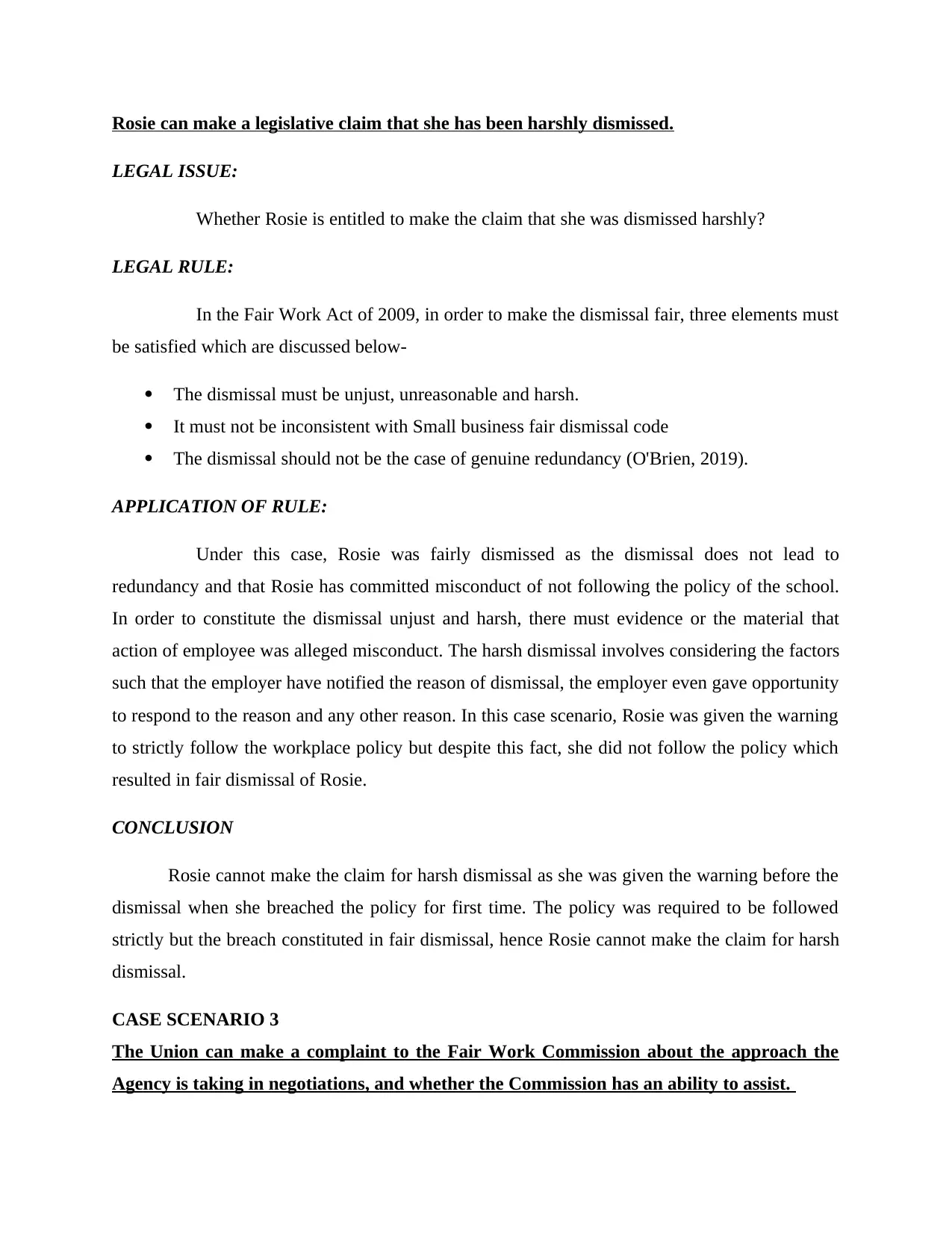
Rosie can make a legislative claim that she has been harshly dismissed.
LEGAL ISSUE:
Whether Rosie is entitled to make the claim that she was dismissed harshly?
LEGAL RULE:
In the Fair Work Act of 2009, in order to make the dismissal fair, three elements must
be satisfied which are discussed below-
The dismissal must be unjust, unreasonable and harsh.
It must not be inconsistent with Small business fair dismissal code
The dismissal should not be the case of genuine redundancy (O'Brien, 2019).
APPLICATION OF RULE:
Under this case, Rosie was fairly dismissed as the dismissal does not lead to
redundancy and that Rosie has committed misconduct of not following the policy of the school.
In order to constitute the dismissal unjust and harsh, there must evidence or the material that
action of employee was alleged misconduct. The harsh dismissal involves considering the factors
such that the employer have notified the reason of dismissal, the employer even gave opportunity
to respond to the reason and any other reason. In this case scenario, Rosie was given the warning
to strictly follow the workplace policy but despite this fact, she did not follow the policy which
resulted in fair dismissal of Rosie.
CONCLUSION
Rosie cannot make the claim for harsh dismissal as she was given the warning before the
dismissal when she breached the policy for first time. The policy was required to be followed
strictly but the breach constituted in fair dismissal, hence Rosie cannot make the claim for harsh
dismissal.
CASE SCENARIO 3
The Union can make a complaint to the Fair Work Commission about the approach the
Agency is taking in negotiations, and whether the Commission has an ability to assist.
LEGAL ISSUE:
Whether Rosie is entitled to make the claim that she was dismissed harshly?
LEGAL RULE:
In the Fair Work Act of 2009, in order to make the dismissal fair, three elements must
be satisfied which are discussed below-
The dismissal must be unjust, unreasonable and harsh.
It must not be inconsistent with Small business fair dismissal code
The dismissal should not be the case of genuine redundancy (O'Brien, 2019).
APPLICATION OF RULE:
Under this case, Rosie was fairly dismissed as the dismissal does not lead to
redundancy and that Rosie has committed misconduct of not following the policy of the school.
In order to constitute the dismissal unjust and harsh, there must evidence or the material that
action of employee was alleged misconduct. The harsh dismissal involves considering the factors
such that the employer have notified the reason of dismissal, the employer even gave opportunity
to respond to the reason and any other reason. In this case scenario, Rosie was given the warning
to strictly follow the workplace policy but despite this fact, she did not follow the policy which
resulted in fair dismissal of Rosie.
CONCLUSION
Rosie cannot make the claim for harsh dismissal as she was given the warning before the
dismissal when she breached the policy for first time. The policy was required to be followed
strictly but the breach constituted in fair dismissal, hence Rosie cannot make the claim for harsh
dismissal.
CASE SCENARIO 3
The Union can make a complaint to the Fair Work Commission about the approach the
Agency is taking in negotiations, and whether the Commission has an ability to assist.
Paraphrase This Document
Need a fresh take? Get an instant paraphrase of this document with our AI Paraphraser
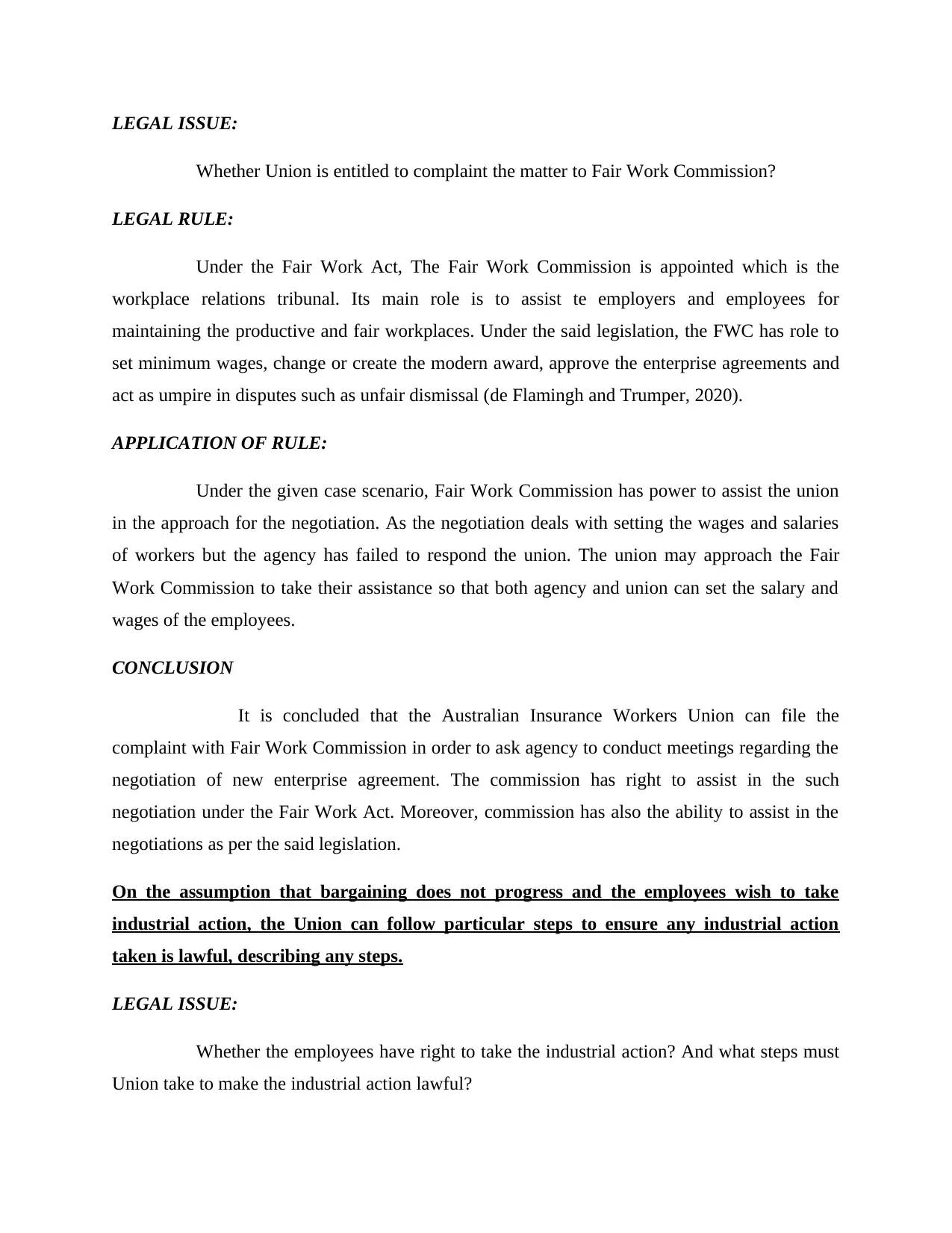
LEGAL ISSUE:
Whether Union is entitled to complaint the matter to Fair Work Commission?
LEGAL RULE:
Under the Fair Work Act, The Fair Work Commission is appointed which is the
workplace relations tribunal. Its main role is to assist te employers and employees for
maintaining the productive and fair workplaces. Under the said legislation, the FWC has role to
set minimum wages, change or create the modern award, approve the enterprise agreements and
act as umpire in disputes such as unfair dismissal (de Flamingh and Trumper, 2020).
APPLICATION OF RULE:
Under the given case scenario, Fair Work Commission has power to assist the union
in the approach for the negotiation. As the negotiation deals with setting the wages and salaries
of workers but the agency has failed to respond the union. The union may approach the Fair
Work Commission to take their assistance so that both agency and union can set the salary and
wages of the employees.
CONCLUSION
It is concluded that the Australian Insurance Workers Union can file the
complaint with Fair Work Commission in order to ask agency to conduct meetings regarding the
negotiation of new enterprise agreement. The commission has right to assist in the such
negotiation under the Fair Work Act. Moreover, commission has also the ability to assist in the
negotiations as per the said legislation.
On the assumption that bargaining does not progress and the employees wish to take
industrial action, the Union can follow particular steps to ensure any industrial action
taken is lawful, describing any steps.
LEGAL ISSUE:
Whether the employees have right to take the industrial action? And what steps must
Union take to make the industrial action lawful?
Whether Union is entitled to complaint the matter to Fair Work Commission?
LEGAL RULE:
Under the Fair Work Act, The Fair Work Commission is appointed which is the
workplace relations tribunal. Its main role is to assist te employers and employees for
maintaining the productive and fair workplaces. Under the said legislation, the FWC has role to
set minimum wages, change or create the modern award, approve the enterprise agreements and
act as umpire in disputes such as unfair dismissal (de Flamingh and Trumper, 2020).
APPLICATION OF RULE:
Under the given case scenario, Fair Work Commission has power to assist the union
in the approach for the negotiation. As the negotiation deals with setting the wages and salaries
of workers but the agency has failed to respond the union. The union may approach the Fair
Work Commission to take their assistance so that both agency and union can set the salary and
wages of the employees.
CONCLUSION
It is concluded that the Australian Insurance Workers Union can file the
complaint with Fair Work Commission in order to ask agency to conduct meetings regarding the
negotiation of new enterprise agreement. The commission has right to assist in the such
negotiation under the Fair Work Act. Moreover, commission has also the ability to assist in the
negotiations as per the said legislation.
On the assumption that bargaining does not progress and the employees wish to take
industrial action, the Union can follow particular steps to ensure any industrial action
taken is lawful, describing any steps.
LEGAL ISSUE:
Whether the employees have right to take the industrial action? And what steps must
Union take to make the industrial action lawful?

LEGAL RULE:
Under the Fair Work Act, there are two types of industrial action which includes
firstly the unprotected and second is protected. It is authorized when the employer and
employees are negotiating on the proposed enterprise agreement. It is protected when the
employee’s action is to support the claims which are in relation to enterprise agreement
(Clibborn and Wright, 2018).
APPLICATION OF RULE:
The Union must ensure that it applies to the Fair Commission for the protected action
ballot order and this application can be made only when the employer have issued the notice of
the representational rights to its employees. The Union must ensure that its application should
specify the group of workforce which is to be balloted including the questions which are to be
put in it.
The copy of the application should be provided to ballot agent and employees within
24 hours of application and tis ballot gives the chance to employees to vote as to whether they
want to initiate the protected industrial action. A notice must be given to the employees and the
union must take all steps in order to notify the workers.
CONCLUSION:
It is concluded that the Union can initiate the protected industrial action when the agency
is not negotiating or responding to the emails of union. Under the Fair Work Act, the employees
have right to initiate the industrial action but it has follow a procedure in order to make it the
protected industrial action.
CASE SCENARIO 4
He can require Pete to attend the other restaurant, as part of his duties.
LEGAL ISSUE:
Whether Pete is required to attend other restaurant as per its duties?
LEGAL RULE:
Under the Fair Work Act, there are two types of industrial action which includes
firstly the unprotected and second is protected. It is authorized when the employer and
employees are negotiating on the proposed enterprise agreement. It is protected when the
employee’s action is to support the claims which are in relation to enterprise agreement
(Clibborn and Wright, 2018).
APPLICATION OF RULE:
The Union must ensure that it applies to the Fair Commission for the protected action
ballot order and this application can be made only when the employer have issued the notice of
the representational rights to its employees. The Union must ensure that its application should
specify the group of workforce which is to be balloted including the questions which are to be
put in it.
The copy of the application should be provided to ballot agent and employees within
24 hours of application and tis ballot gives the chance to employees to vote as to whether they
want to initiate the protected industrial action. A notice must be given to the employees and the
union must take all steps in order to notify the workers.
CONCLUSION:
It is concluded that the Union can initiate the protected industrial action when the agency
is not negotiating or responding to the emails of union. Under the Fair Work Act, the employees
have right to initiate the industrial action but it has follow a procedure in order to make it the
protected industrial action.
CASE SCENARIO 4
He can require Pete to attend the other restaurant, as part of his duties.
LEGAL ISSUE:
Whether Pete is required to attend other restaurant as per its duties?
LEGAL RULE:
⊘ This is a preview!⊘
Do you want full access?
Subscribe today to unlock all pages.

Trusted by 1+ million students worldwide
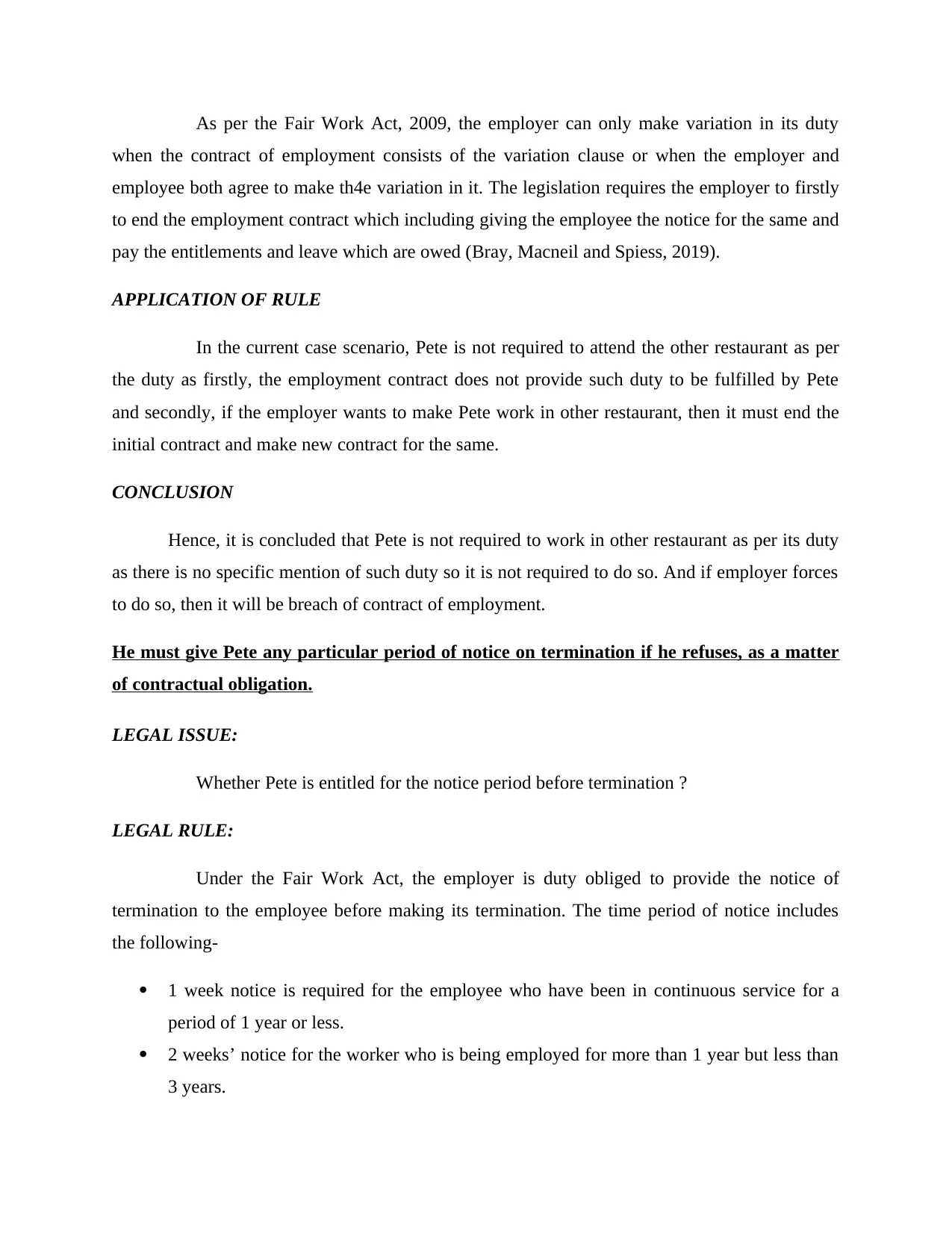
As per the Fair Work Act, 2009, the employer can only make variation in its duty
when the contract of employment consists of the variation clause or when the employer and
employee both agree to make th4e variation in it. The legislation requires the employer to firstly
to end the employment contract which including giving the employee the notice for the same and
pay the entitlements and leave which are owed (Bray, Macneil and Spiess, 2019).
APPLICATION OF RULE
In the current case scenario, Pete is not required to attend the other restaurant as per
the duty as firstly, the employment contract does not provide such duty to be fulfilled by Pete
and secondly, if the employer wants to make Pete work in other restaurant, then it must end the
initial contract and make new contract for the same.
CONCLUSION
Hence, it is concluded that Pete is not required to work in other restaurant as per its duty
as there is no specific mention of such duty so it is not required to do so. And if employer forces
to do so, then it will be breach of contract of employment.
He must give Pete any particular period of notice on termination if he refuses, as a matter
of contractual obligation.
LEGAL ISSUE:
Whether Pete is entitled for the notice period before termination ?
LEGAL RULE:
Under the Fair Work Act, the employer is duty obliged to provide the notice of
termination to the employee before making its termination. The time period of notice includes
the following-
1 week notice is required for the employee who have been in continuous service for a
period of 1 year or less.
2 weeks’ notice for the worker who is being employed for more than 1 year but less than
3 years.
when the contract of employment consists of the variation clause or when the employer and
employee both agree to make th4e variation in it. The legislation requires the employer to firstly
to end the employment contract which including giving the employee the notice for the same and
pay the entitlements and leave which are owed (Bray, Macneil and Spiess, 2019).
APPLICATION OF RULE
In the current case scenario, Pete is not required to attend the other restaurant as per
the duty as firstly, the employment contract does not provide such duty to be fulfilled by Pete
and secondly, if the employer wants to make Pete work in other restaurant, then it must end the
initial contract and make new contract for the same.
CONCLUSION
Hence, it is concluded that Pete is not required to work in other restaurant as per its duty
as there is no specific mention of such duty so it is not required to do so. And if employer forces
to do so, then it will be breach of contract of employment.
He must give Pete any particular period of notice on termination if he refuses, as a matter
of contractual obligation.
LEGAL ISSUE:
Whether Pete is entitled for the notice period before termination ?
LEGAL RULE:
Under the Fair Work Act, the employer is duty obliged to provide the notice of
termination to the employee before making its termination. The time period of notice includes
the following-
1 week notice is required for the employee who have been in continuous service for a
period of 1 year or less.
2 weeks’ notice for the worker who is being employed for more than 1 year but less than
3 years.
Paraphrase This Document
Need a fresh take? Get an instant paraphrase of this document with our AI Paraphraser
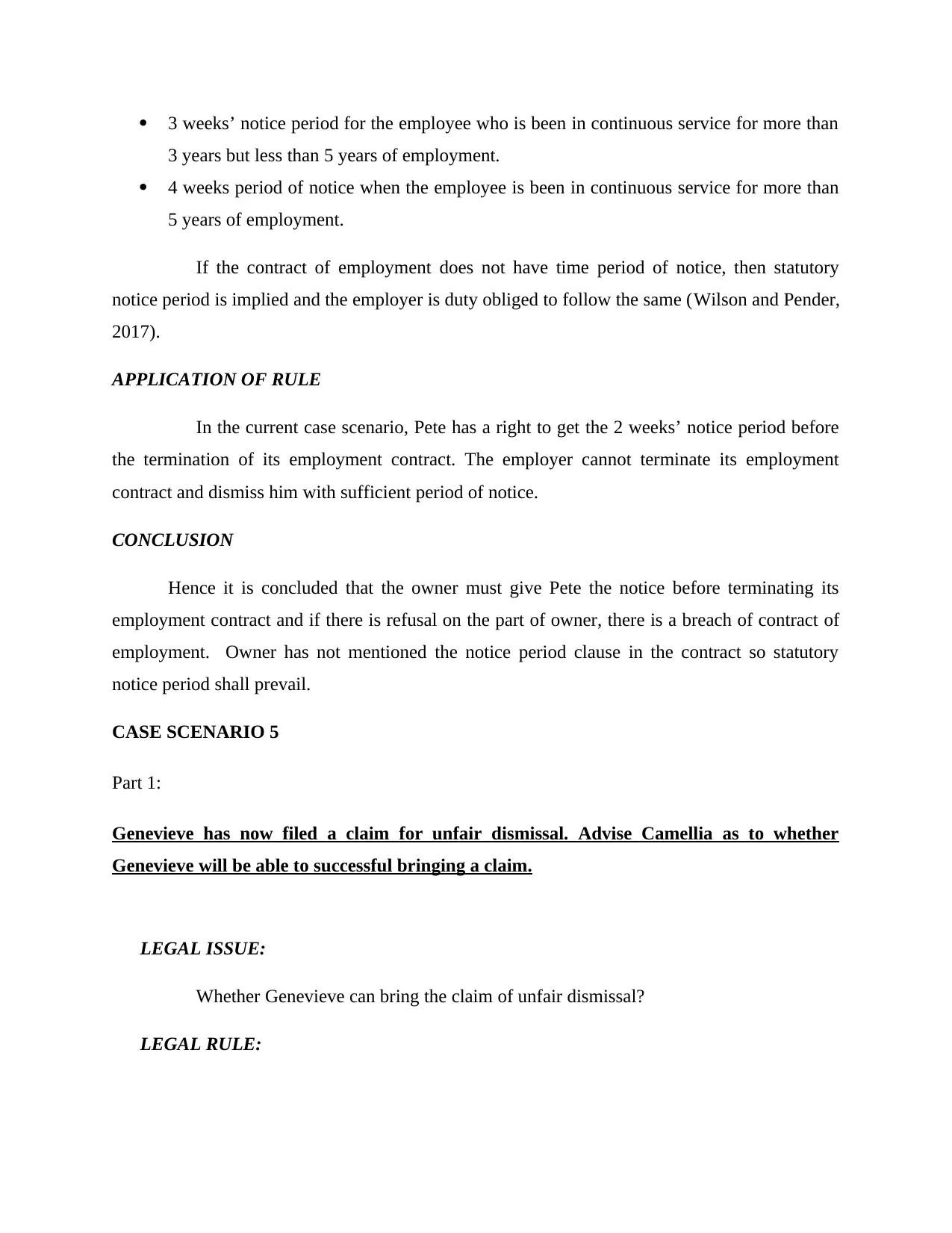
3 weeks’ notice period for the employee who is been in continuous service for more than
3 years but less than 5 years of employment.
4 weeks period of notice when the employee is been in continuous service for more than
5 years of employment.
If the contract of employment does not have time period of notice, then statutory
notice period is implied and the employer is duty obliged to follow the same (Wilson and Pender,
2017).
APPLICATION OF RULE
In the current case scenario, Pete has a right to get the 2 weeks’ notice period before
the termination of its employment contract. The employer cannot terminate its employment
contract and dismiss him with sufficient period of notice.
CONCLUSION
Hence it is concluded that the owner must give Pete the notice before terminating its
employment contract and if there is refusal on the part of owner, there is a breach of contract of
employment. Owner has not mentioned the notice period clause in the contract so statutory
notice period shall prevail.
CASE SCENARIO 5
Part 1:
Genevieve has now filed a claim for unfair dismissal. Advise Camellia as to whether
Genevieve will be able to successful bringing a claim.
LEGAL ISSUE:
Whether Genevieve can bring the claim of unfair dismissal?
LEGAL RULE:
3 years but less than 5 years of employment.
4 weeks period of notice when the employee is been in continuous service for more than
5 years of employment.
If the contract of employment does not have time period of notice, then statutory
notice period is implied and the employer is duty obliged to follow the same (Wilson and Pender,
2017).
APPLICATION OF RULE
In the current case scenario, Pete has a right to get the 2 weeks’ notice period before
the termination of its employment contract. The employer cannot terminate its employment
contract and dismiss him with sufficient period of notice.
CONCLUSION
Hence it is concluded that the owner must give Pete the notice before terminating its
employment contract and if there is refusal on the part of owner, there is a breach of contract of
employment. Owner has not mentioned the notice period clause in the contract so statutory
notice period shall prevail.
CASE SCENARIO 5
Part 1:
Genevieve has now filed a claim for unfair dismissal. Advise Camellia as to whether
Genevieve will be able to successful bringing a claim.
LEGAL ISSUE:
Whether Genevieve can bring the claim of unfair dismissal?
LEGAL RULE:
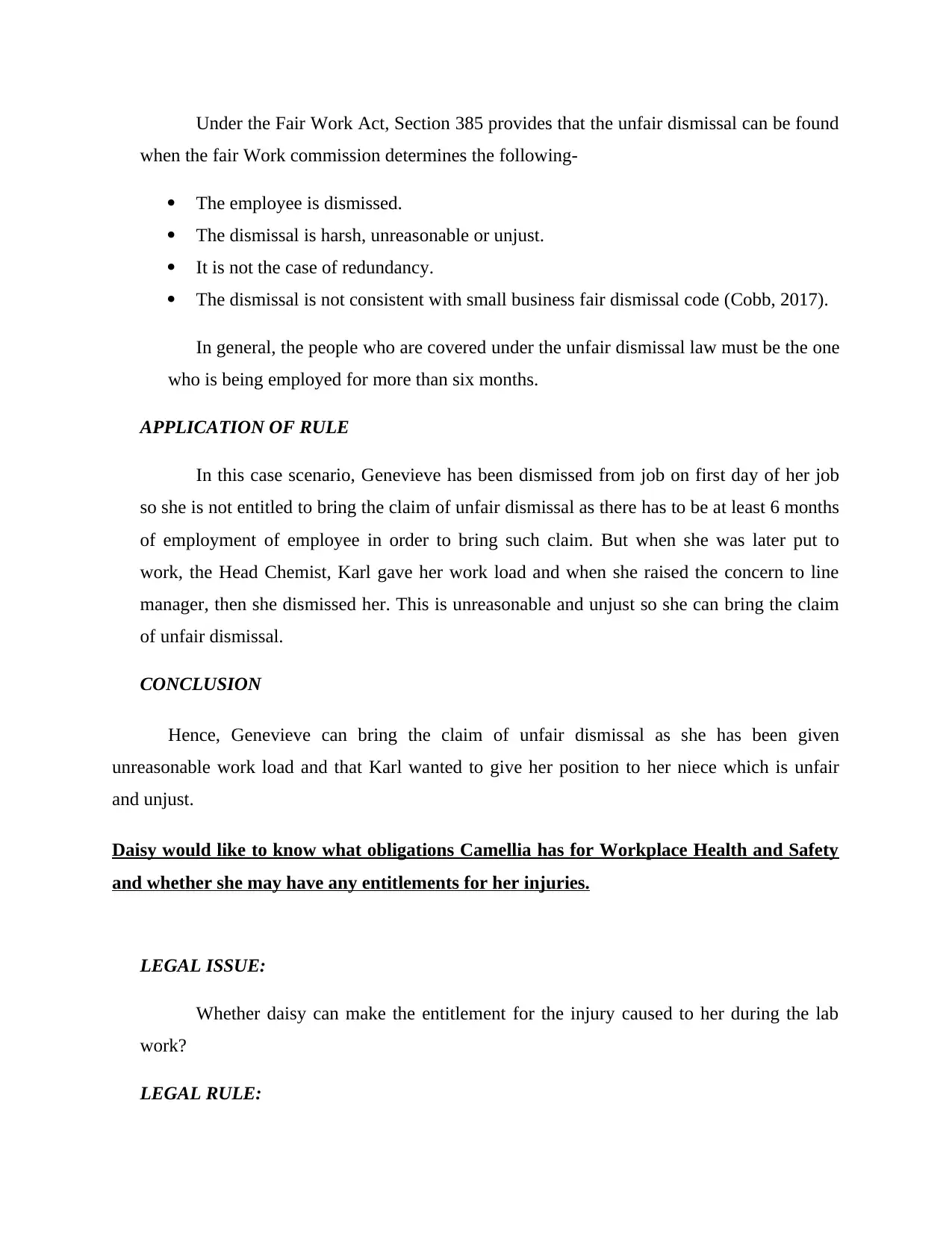
Under the Fair Work Act, Section 385 provides that the unfair dismissal can be found
when the fair Work commission determines the following-
The employee is dismissed.
The dismissal is harsh, unreasonable or unjust.
It is not the case of redundancy.
The dismissal is not consistent with small business fair dismissal code (Cobb, 2017).
In general, the people who are covered under the unfair dismissal law must be the one
who is being employed for more than six months.
APPLICATION OF RULE
In this case scenario, Genevieve has been dismissed from job on first day of her job
so she is not entitled to bring the claim of unfair dismissal as there has to be at least 6 months
of employment of employee in order to bring such claim. But when she was later put to
work, the Head Chemist, Karl gave her work load and when she raised the concern to line
manager, then she dismissed her. This is unreasonable and unjust so she can bring the claim
of unfair dismissal.
CONCLUSION
Hence, Genevieve can bring the claim of unfair dismissal as she has been given
unreasonable work load and that Karl wanted to give her position to her niece which is unfair
and unjust.
Daisy would like to know what obligations Camellia has for Workplace Health and Safety
and whether she may have any entitlements for her injuries.
LEGAL ISSUE:
Whether daisy can make the entitlement for the injury caused to her during the lab
work?
LEGAL RULE:
when the fair Work commission determines the following-
The employee is dismissed.
The dismissal is harsh, unreasonable or unjust.
It is not the case of redundancy.
The dismissal is not consistent with small business fair dismissal code (Cobb, 2017).
In general, the people who are covered under the unfair dismissal law must be the one
who is being employed for more than six months.
APPLICATION OF RULE
In this case scenario, Genevieve has been dismissed from job on first day of her job
so she is not entitled to bring the claim of unfair dismissal as there has to be at least 6 months
of employment of employee in order to bring such claim. But when she was later put to
work, the Head Chemist, Karl gave her work load and when she raised the concern to line
manager, then she dismissed her. This is unreasonable and unjust so she can bring the claim
of unfair dismissal.
CONCLUSION
Hence, Genevieve can bring the claim of unfair dismissal as she has been given
unreasonable work load and that Karl wanted to give her position to her niece which is unfair
and unjust.
Daisy would like to know what obligations Camellia has for Workplace Health and Safety
and whether she may have any entitlements for her injuries.
LEGAL ISSUE:
Whether daisy can make the entitlement for the injury caused to her during the lab
work?
LEGAL RULE:
⊘ This is a preview!⊘
Do you want full access?
Subscribe today to unlock all pages.

Trusted by 1+ million students worldwide
1 out of 19
Related Documents
Your All-in-One AI-Powered Toolkit for Academic Success.
+13062052269
info@desklib.com
Available 24*7 on WhatsApp / Email
![[object Object]](/_next/static/media/star-bottom.7253800d.svg)
Unlock your academic potential
Copyright © 2020–2025 A2Z Services. All Rights Reserved. Developed and managed by ZUCOL.





